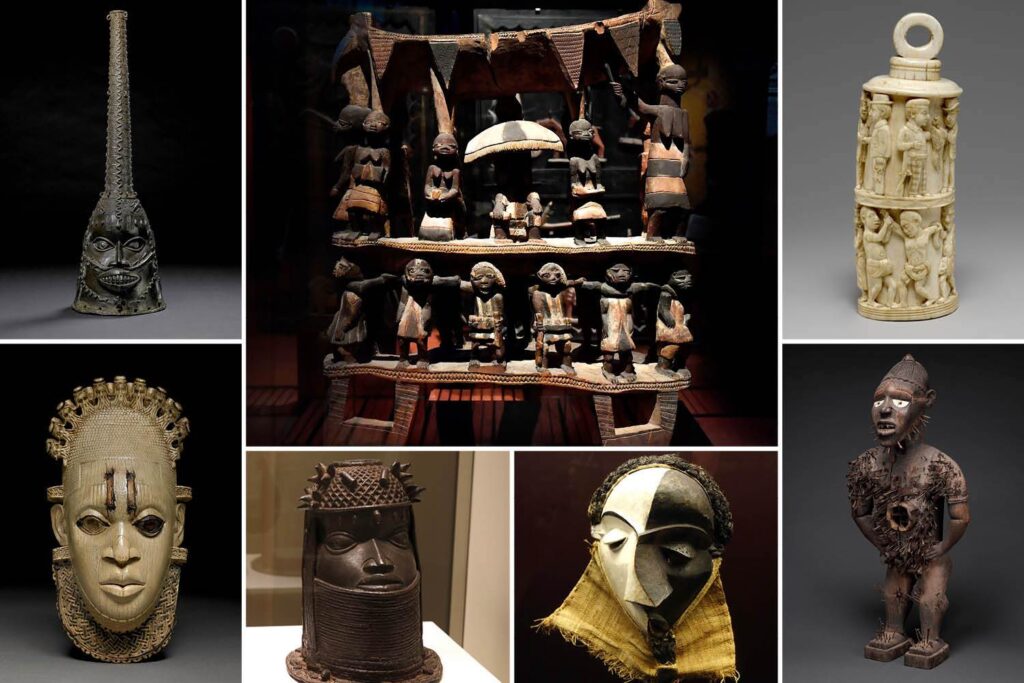Years after most African countries colonised by the Europeans have gained their independence there are increasing calls for Europe to return the various cultural artifacts and treasures they stole from the African continent.
As Europe colonised Africa they plundered the continent and carted away its rich cultural artifacts and heritage to their European museums.
Here are some of the best artifacts and cultural treasures that has been stolen from Africa by the Europeans during the course of colonisation.
Benin Bronzes

These are one of the most famous artefacts stolen by the British. The Benin bronzes are a collection of sculptures made of brass that adorned the royal palace of the Oba of Benin, Ovonramwen Nogbaisi.
The pieces were carved usually out of brass, ivory, ceramic and wood and were cast for the ancestral altars of past kings and queen mothers.
In 1897 during an expedition against Benin, bronze sculptures and plaques, innumerable royal objects were taken as a result of the mission and are scattered all over the world.
Man Eaters of Tsavo

At the end of the 19th century two lions from the Tsavo region in Kenya killed and ate railway workers who were building the railway line between Mombasa and Lake Victoria over nine months in 1898.
British engineer Lieutenant Colonel John Patterson, who was heading the project, later shot dead the two killer beasts.
The stuffed lions were purchased from Patterson by the Field Museum of Natural History in the US city of Chicago in 1925 and catalogued into the museum’s permanent collections. The Kenya National Museum now want the lions returned.
The Rosetta Stone

The Rosetta Stone is a broken part of a bigger slab with text carved on to it that has helped researchers learn how to read Egyptian hieroglyphs – a form of writing that used pictures as signs.
It has three columns of the same inscription in three languages: Greek, hieroglyphs and demotic Egyptian – and is the text of a decree written by priests in 196 BC, during the reign of pharaoh Ptolemy V.
It is unclear how the stone was discovered in July 1799, but there’s a general belief that it was found by soldiers fighting with the French military leader Napoleon Bonaparte as they were building an extension to a fort near the town of Rashid – also known as Rosetta – in the Nile Delta.
When Napoleon was defeated, the British took possession of the stone under the terms of the Treaty of Alexandria in 1801.
It was then transported to England, arriving in Portsmouth in February 1802. George III offered it to the British Museum a few months later.
The Maqdala Treasures

The Maqdala treasures include an 18th Century gold crown and a royal wedding dress, taken from Ethiopia (formerly Abyssinia) by the British army in 1868.
According to Historians, 15 elephants and 200 mules were needed to cart away all the loot from Maqdala, Emperor Tewodros II’s northern citadel capital.
The British raided Maqdala in protest at the detention of its consul when relations between the two powers deteriorated.

The crown, admired for its silver and copper filigree designs and religious embossed images, and royal wedding dress are significant symbols of the Ethiopian Orthodox Church.
Scholars believe the crown was commissioned in the 1740s by Empress Mentewwab and her son King Iyyasu and given as a gift to a church in Gondar, together with a solid gold chalice.
The dress and jewellery belonged to Emperor Tewodros II’s widow, Queen Woyzaro Terunesh.
Bangwa Queen from Cameroon

The Bangwa Queen is a 32in (81cm) tall wooden carving from Cameroon, representing the power and health of the Bangwa people.
It is one of the world’s most famous pieces of African art and has huge sacred significance for Cameroonians.
Sculptures were made of titled royal wives or princesses and would be referred to as Bangwa Queens in the Bangwa land of present-day Lebialem district of Cameroon’s South-West region
The Bangwa Queen was believed to have either been given to or looted by the German colonial agent Gustav Conrau around 1899 before the territory was colonised.
It ended up in the Museum für Völkerkunde in Berlin and was then bought by an art collector in 1926.
The Dapper Foundation in Paris, France now owns the Bangwa Queen sculpture – and it was on display at the Musée Dapper until 2017 when the museum that focused on African art closed because of low attendance and high maintenance costs.
Traditional leaders of the Bangwa have been corresponding with the foundation, requesting its return to Cameroon.
Soapstone Birds of Zimbabwe

A soapstone sculpture of a fish eagle is Zimbabwe’s main national emblem. Eight of the Zimbabwe Birds were looted from the ruins of an ancient city.
Only eight of the birds were ever recovered. They stood on the walls and monoliths of the ancient city built between the 12th and 15th Centuries by the ancestors of the Shona people.
Credits: The BBC
Recommended Read: 10 Most Outdated Things Many People Still Use Everyday

